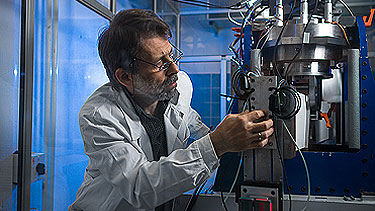Optics

Sponsored by
Exploring the mysteries of the quantum microworld, studying and preparing ultra-thin layers on glass, developing new materials for solar water splitting… research leading to the creation of quantum computers… searching for the best spot on the Earth in order to be able to detect the strongest radiation from the universe…. These and many other fascinating research projects are conducted by the scientists at the joint workplace of Palacký University and the Physical Institute of the Academy of Sciences of the Czech Republic – the Joint Laboratory of Optics (JLO). Their sphere concerns the laws of optics and their “transfer” into practical life.
Optics and mechanics
The basic purpose of the Laboratory is to perform research into applied optics, quantum and nonlinear optics, wave optics, and particle physics. Local experts develop optical devices and cooperate with Czech companies as well as international teams of scientists. They also participate in the education of UP graduate and postgraduate students.
The leader of the research group Quantum and Non-Linear Optics is a scientist of international acclaim, Prof Jan Peřina. His team explores how to employ the laws of quantum mechanics into informatics, communication technologies, and metrology. Their research may lead to improving the existing technologies, or even the development of new ones – such as the building of quantum computers, revealing the principles of quantum teleportation, or quantum cryptography – which may be useful in data encryption.
The research group of Classical Optics and Laser Technologies explores the properties of optical elements and surfaces. The scientists explore thin layers on glass, which are necessary for correct functioning of optical components and developing of any required properties, typically hardness and resistance. Their research visibly helps anyone who wears glasses. The new direction in their research concerns the development of surfaces and films by plasma deposition – these might contribute to a significant increase in the efficiency of cells used for solar photoelectrochemical water splitting.
Another of the JLO research groups has developed a method of measuring infinitesimal shifts on the surface via reflection of laser light. It is used in practice for testing the deformation of aeroplane wings during wing load tests.
Cosmic rays in Argentina
Olomouc scientists are also part of the team at the international Pierre Auger Observatory, the world’s largest observatory employed for research of high-energy cosmic rays. The observatory combines ground and fluorescence detectors made up of 60 mirror segments, each with a surface area of 13 m2. JLO experts also play a crucial role in the team that searches for the most suitable location in the world for the planned observatories for the Cherenkov Telescope Array (CTA) project. They have installed special cameras at prospective places such as the Canary Islands and Namibia, which monitor the local average cloud cover.